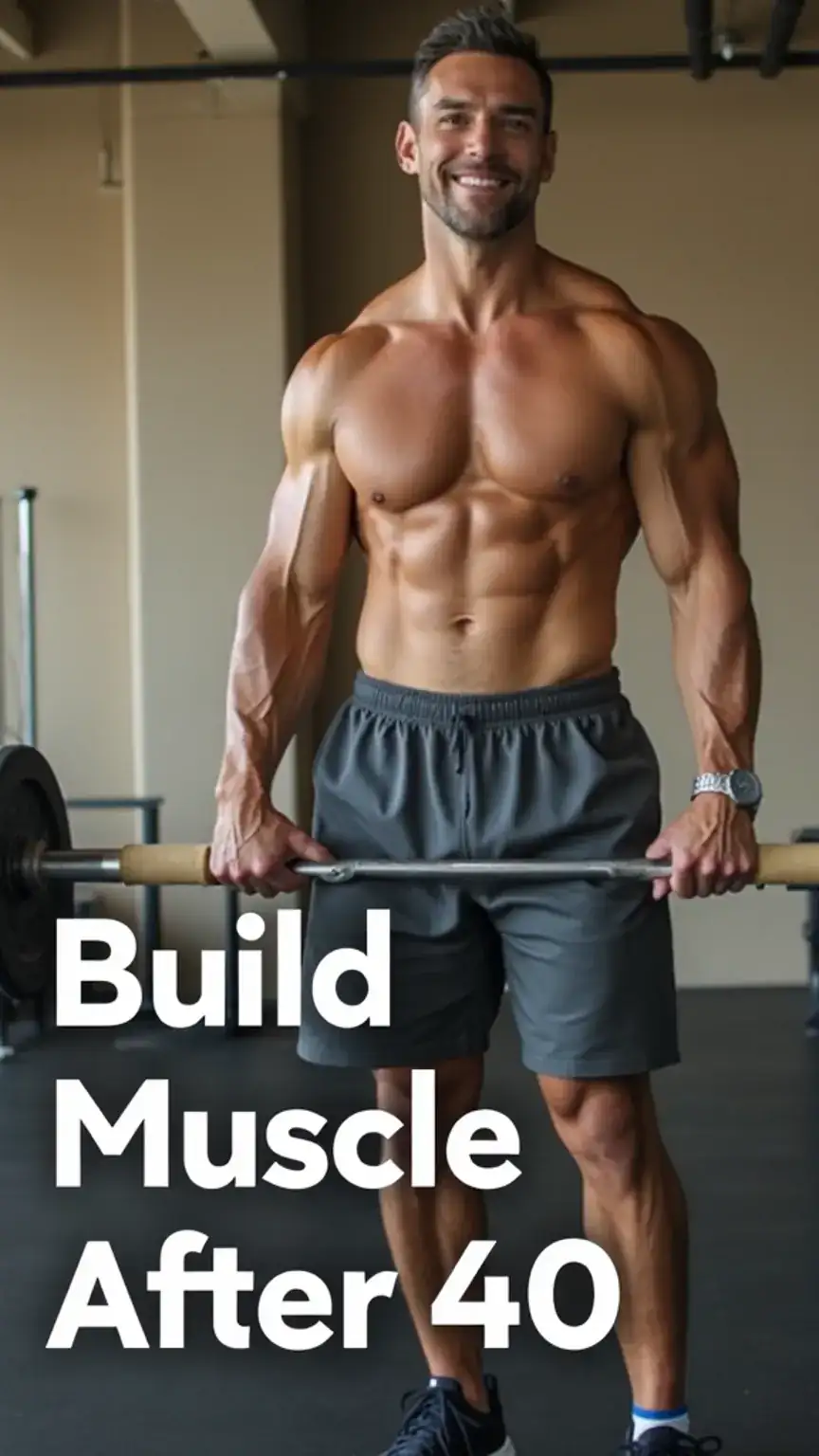As guys, we’re wired to push, to conquer, and to build. It’s in our DNA. But somewhere between that youthful exuberance and the responsibilities of adulthood, something shifts. The metabolism slows, the recovery takes longer, and that built-in resilience feels… well, a bit more fragile. Suddenly, “building muscle and strength as you age” can sound less like an exciting challenge and more like an uphill battle against Father Time.

You’ve been there. Maybe you’re noticing that your favorite jeans fit a little tighter, or perhaps you’re just not as spry as you used to be. The thought of hitting the gym can feel less motivating when you’re not seeing the same rapid results you did in your twenties. Because let’s face it—your “casual Friday” tee shouldn’t double as a pajama top. This is where many men hit a wall, feeling like their best physical years are behind them.
But what if I told you that’s a myth? What if you could not only maintain but actively build muscle and strength, even as the calendar pages flip? Imagine walking into a room where your confidence precedes you, not just from a sharp suit, but from the quiet power of a strong, capable physique. It’s entirely achievable. As Mercer Wexley, a man who’s navigating his own journey through the latter half of life with style and substance, I’ve learned that aging doesn’t have to mean declining. It can, in fact, be a period of refined strength and purpose.
So, let’s ditch the defeatist mindset. We’re diving deep into practical, actionable strategies that will have you feeling and looking your best, no matter your age. This isn’t about chasing impossible ideals; it’s about smart training, intelligent nutrition, and the unwavering commitment that defines a man of substance. Let’s unlock that latent power and prove that age is just a number when it comes to building a stronger you.
Step 1: Set Realistic Expectations – The Foundation of Smart Training
First and foremost, it’s essential to set realistic expectations. Don’t try to be a 25-year-old again, because let’s face it, that’s just not going to happen. Your body has different needs and capabilities now. Trying to replicate your younger self’s training or recovery patterns is a recipe for frustration and potential injury. Instead, focus on making consistent progress and celebrating the small victories along the way.
This means shifting your perspective from rapid gains to sustainable improvement. It’s a journey, not a destination you can sprint towards. For example, if you’re aiming to increase your bench press, setting a goal to add 5 pounds every month is far more realistic and motivating than expecting to add 20 pounds overnight.
Furthermore, remember that consistency is your greatest ally here.

Embracing the Long Game
Think of it like investing in a fine whiskey or a classic watch. The real value comes from patience, care, and an understanding of the aging process. Your body is no different. Celebrate lifting a slightly heavier weight, completing an extra repetition, or feeling more energetic after a workout. These are the milestones that build momentum.
For instance, Dave, a 45-year-old accountant who landed his dream client after revamping his LinkedIn profile photo, found that focusing on consistent, small improvements in his personal branding led to significant career growth.
This mindset shift is crucial because it prevents burnout and keeps you engaged. When you’re not constantly comparing yourself to an unrealistic past or an idealized future, you can appreciate the progress you’re actually making.
Consequently, this leads to a more enjoyable and ultimately more successful fitness journey.
Step 2: Focus on Progressive Overload – The Engine of Muscle Growth
Progressive overload is the absolute key to building muscle and strength, regardless of age. This principle simply means gradually increasing the demands placed on your muscles over time. You can’t keep doing the same thing and expect different results, right? It’s about consistently challenging your body to adapt and get stronger.

This means gradually increasing the weight or resistance you’re lifting. Don’t be afraid to challenge yourself and push your limits, but also make sure to listen to your body. Taking rest days when needed is not a sign of weakness; it’s a crucial part of the adaptation process.
For example, if you comfortably bench press 150 pounds for 8 reps, the next time you might aim for 155 pounds for 6-8 reps, or perhaps try to get 9 reps with 150 pounds.
Smart Ways to Apply Progressive Overload
There are several ways to implement progressive overload beyond just adding weight. You can increase the number of repetitions within a set, add an extra set, decrease rest times between sets, or improve your lifting form for better muscle activation.
Similarly, incorporating tempo training, where you control the speed of each part of the lift, can also be a form of progressive overload.
Pro Tip: Adding a stylish element (like progressive overload) elevates your overall presentation. However, always prioritize proper form to prevent injury.
Step 3: Eat to Support Your Goals – Fueling the Machine
When it comes to building muscle, nutrition is just as important as exercise. You can’t out-train a bad diet, especially as you get older. Your body needs the right building blocks to repair and grow muscle tissue. Make sure to fuel your body with a balanced diet that includes plenty of protein, complex carbohydrates, and healthy fats.

Protein is essential for muscle protein synthesis, the process by which muscles repair and grow. Aim for around 0.7 to 1 gram of protein per pound of body weight daily. This might sound like a lot, but it’s achievable with smart food choices.
For instance, incorporating a protein shake after your workout is a convenient way to kickstart recovery.
The Macronutrient Mix for Men Over 40
Complex carbohydrates provide sustained energy for your workouts and help replenish glycogen stores, which are crucial for performance and recovery. Think whole grains, fruits, and vegetables. Healthy fats are vital for hormone production, including testosterone, which plays a significant role in muscle growth. Sources include avocados, nuts, seeds, and olive oil.
And don’t forget to stay hydrated – it’s essential for optimal performance and recovery. Dehydration can significantly impair your ability to train effectively and recover properly.
Consequently, keeping a water bottle with you throughout the day is a simple yet powerful habit.
Step 4: Prioritize Sleep and Recovery – The Unsung Heroes
Sleep is crucial for muscle recovery and growth. While you’re sleeping, your body is busy repairing muscle tissue and releasing growth hormones. Aim for 7-9 hours of quality sleep each night. This isn’t a luxury; it’s a necessity for anyone serious about building muscle and strength.

Prioritize a consistent sleep schedule, even on weekends. This helps regulate your body’s natural circadian rhythm, making it easier to fall asleep and wake up feeling refreshed. You can also try incorporating relaxation techniques, such as meditation or deep breathing, to help you unwind and prepare for a good night’s sleep. For example, a 15-minute meditation before bed can make a world of difference.
For a deeper dive into proven strategies to boost your rest, check out my guide on improving sleep quality for better health and performance — because great workouts start with great recovery.
Active Recovery and Stress Management
Beyond sleep, active recovery plays a vital role. This involves low-intensity activities like walking, light stretching, or foam rolling on your rest days. These activities help improve blood flow to your muscles, which aids in recovery and reduces soreness. Furthermore, managing stress is equally important. Chronic stress can elevate cortisol levels, a hormone that can hinder muscle growth and promote fat storage.
Take it from Mercer himself: a 50-year-old former automotive marketing director who found that prioritizing sleep and incorporating mindfulness practices significantly boosted his energy levels and workout performance. Your future self will thank you for reading this. Indeed, 90% of recruiters judge your credibility by your profile pic—here’s how to ace it. Similarly, your body judges your commitment to recovery by the quality of your sleep.
Step 5: Stay Consistent and Adapt – The Marathon Mentality
Consistency is the bedrock of building muscle and strength, especially as you age. Make sure to stick to your workout routine and nutrition plan, even when you don’t feel like it. Life happens, and there will be days when motivation wanes or unexpected events disrupt your schedule.

The key is not to be perfect, but to be persistent. Don’t be too hard on yourself if you miss a workout or have an off-plan meal. Just get back on track with your next meal or your next scheduled workout. It’s the cumulative effect of consistent effort over time that yields results. For example, if you miss a Monday workout, don’t try to cram two workouts into Tuesday; just pick up where you left off on Wednesday.
Listening to Your Body and Adjusting
As you age, your body’s signals become even more important. Learn to differentiate between muscle soreness (Delayed Onset Muscle Soreness or DOMS) and actual pain. Pushing through sharp or persistent pain can lead to serious injuries that will set you back far more than a missed workout.
Listen to your body and be willing to adapt your training. If you’re feeling particularly fatigued, a lighter session or an extra rest day might be more beneficial than pushing through a heavy lift. Similarly, if a particular exercise consistently causes discomfort, explore alternative exercises that target the same muscle groups but are more joint-friendly. This adaptability is what allows for long-term, sustainable progress.
Step 6: Embrace Compound Movements – Efficiency is Key
When time is precious and your body’s recovery capacity might be slightly reduced, efficiency in your training is paramount. Compound movements are exercises that work multiple muscle groups simultaneously. They are the cornerstone of any effective strength-building program, especially for men over 40.
These multi-joint exercises recruit more muscle fibers, stimulate a greater hormonal response, and burn more calories than isolation exercises. Think of them as the heavy artillery in your muscle-building arsenal. For instance, squats, deadlifts, bench presses, overhead presses, and rows are foundational compound movements. Mastering these lifts will give you the most bang for your buck.
Maximizing Your Workout with Compound Lifts
Focusing your training around these core lifts ensures that you’re building functional strength that translates to everyday life. Whether it’s picking up your kids, carrying groceries, or tackling a DIY project, strong, balanced muscles built through compound movements will make it easier. Furthermore, they are highly effective for building overall muscle mass and increasing strength.
Pro Tip: Pair your strength training with a good quality protein powder like this whey protein powder to maximize post-workout recovery.
Just as you choose the right tools for a job, choose the right exercises for your goals. Consequently, incorporating these movements strategically will accelerate your progress.
Step 7: Consider Supplements Wisely – Enhancing Your Efforts
While a solid diet and training regimen are non-negotiable, certain supplements can offer a helpful edge, especially for men navigating the aging process. It’s important to approach supplements with a discerning eye, understanding that they are meant to supplement a healthy lifestyle, not replace it. Because let’s face it – no supplement is a magic bullet.
Creatine Monohydrate is perhaps the most well-researched and effective supplement for increasing strength and muscle mass. It helps your muscles produce energy during high-intensity exercise. Protein powders, as mentioned, are excellent for ensuring adequate protein intake, especially post-workout. For example, a good quality whey or casein protein can significantly aid muscle repair.
Supplements for the Mature Man
Other supplements that might be beneficial include Vitamin D, which plays a role in testosterone production and muscle function, and Omega-3 fatty acids, which can help reduce inflammation and improve recovery. Fish oil or algal oil are great sources. Furthermore, a good multivitamin can help fill any nutritional gaps.
Take it from Mark, a 55-year-old who noticed a significant boost in his workout intensity after starting creatine. Always consult with a healthcare professional before starting any new supplement regimen, especially if you have underlying health conditions. Consequently, choosing the right supplements can be a smart way to optimize your results.

Conclusion: Own Your Strength, Own Your Age
Building muscle and strength as you age requires patience, dedication, and a willingness to learn and adapt. It’s not about turning back the clock; it’s about embracing the wisdom and experience that comes with age and channeling it into a stronger, more capable you. By following these tips—setting realistic expectations, focusing on progressive overload, fueling your body intelligently, prioritizing recovery, staying consistent, embracing compound movements, and considering supplements wisely—you can absolutely achieve a stronger, leaner, and more confident physique.
This journey is about more than just aesthetics; it’s about enhancing your quality of life, your resilience, and your overall well-being. Imagine the confidence of knowing your body can still perform, can still grow, can still impress. It’s within your reach.
So, go ahead and take control of your fitness journey – your body (and mind) will thank you for it!
Ready to own your image and your strength? Start by incorporating one new compound exercise into your routine this week and commit to 7-8 hours of sleep per night. Share your #StyleUpgrade and #AgeStronger journey on Pinterest or your favorite socials!
Tag a friend who needs a strength intervention!






